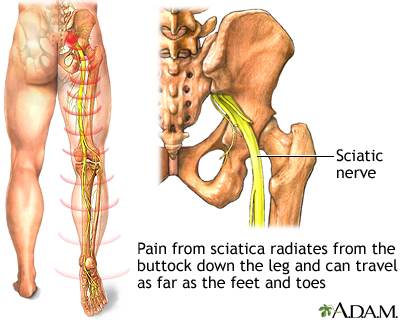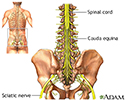Sciatica
Neuropathy - sciatic nerve; Sciatic nerve dysfunction; Low back pain - sciatica; LBP - sciatica; Lumbar radiculopathy - sciaticaSciatica refers to pain, weakness, numbness, or tingling in the leg. It is caused by injury to or pressure on the sciatic nerve. Sciatica is a symptom of a medical problem. It is not a medical condition by itself.
Causes
Sciatica occurs when there is pressure on or damage to the sciatic nerve. This nerve starts in the lower back and runs down the back of each leg. This nerve regulates the muscles of the back of the knee and lower leg. It also provides sensation to the back of the thigh, the outer and back part of the lower leg, and the sole of the foot.
Common causes of sciatica include:
- Slipped or herniated disk
Slipped or herniated disk
A herniated (slipped) disk occurs when all or part of a disk is forced through a weakened part of the disk. This may place pressure on nearby nerves...
 ImageRead Article Now Book Mark Article
ImageRead Article Now Book Mark Article - Spinal stenosis
Spinal stenosis
Spinal stenosis is narrowing of the spinal column that causes pressure on the spinal cord, or narrowing of the openings (called neural foramina) wher...
 ImageRead Article Now Book Mark Article
ImageRead Article Now Book Mark Article - Piriformis syndrome (a pain disorder involving the narrow muscle in the buttocks)
Piriformis syndrome
Piriformis syndrome is pain and numbness in your buttocks and down the back of your leg. It occurs when the piriformis muscle in the buttocks presse...
Read Article Now Book Mark Article - Pelvic injury or fracture
- Tumors
Tumors
A tumor is an abnormal growth of body tissue. Tumors can be cancerous (malignant) or noncancerous (benign).
Read Article Now Book Mark Article - Spondylolisthesis
Spondylolisthesis
Spondylolisthesis is a condition in which a bone (vertebra) in the spine moves forward, out of its proper position, in relation to the bone below it....
Read Article Now Book Mark Article
Men age 30 and 50 years are more likely to have sciatica.
Symptoms
Sciatica pain can vary widely. It may feel like a mild tingling, dull ache, or burning sensation. In some cases, the pain is severe enough to make a person unable to move.
The pain most often occurs on one side of the body. Some people have sharp pain in one part of the leg or hip and numbness in other parts. The pain or numbness may also be felt on the back of the calf or on the sole of the foot. The affected leg may feel weak. Sometimes, your foot gets caught on the ground when walking.
The pain may start slowly. It may get worse:
- After standing or sitting
- During certain times of the day, such as at night
- When sneezing, coughing, or laughing, especially if caused by a herniated disk
- When bending backward or walking more than a few yards or meters, especially if caused by spinal stenosis
- When straining or holding your breath, such as during a bowel movement
Exams and Tests
Your health care provider will perform a physical exam. This may show:
- Weakness when bending the knee
- Difficulty bending the foot inward or down
- Difficulty walking on your toes
- Difficulty bending forward or backward
- Abnormal or weak reflexes
- Loss of sensation or numbness
- Pain when lifting the leg straight up when you're lying on the exam table
Tests are often not needed unless pain is severe or long-lasting. If tests are ordered, they may include:
- X-ray, MRI, or other imaging tests of the spine
X-ray
X-rays are a type of electromagnetic radiation, just like visible light. An x-ray machine sends individual x-ray waves through the body. The images...
 ImageRead Article Now Book Mark Article
ImageRead Article Now Book Mark ArticleMRI
A magnetic resonance imaging (MRI) scan is an imaging test that uses powerful magnets and radio waves to create pictures of the body. It does not us...
 ImageRead Article Now Book Mark Article
ImageRead Article Now Book Mark Article - Blood tests
Treatment
As sciatica is a symptom of a more specific medical condition, the underlying cause should be identified and treated.
In most cases, no surgical treatment is required and recovery occurs with conservative treatment.
Conservative (non-surgical) treatment is best in many cases. Your provider may recommend the following steps to reduce your symptoms:
- Take over-the-counter pain relievers such as ibuprofen (Advil, Motrin IB) or acetaminophen (Tylenol).
- Apply heat or ice to the painful area. Try ice for the first 48 to 72 hours, then use heat.
Measures to take care of your back at home may include:
Take care of your back at home
Low back pain refers to pain that you feel in your lower back. You may also have back stiffness, decreased movement of the lower back, and difficult...

- Bed rest is not recommended.
- Back exercises are recommended early on to strengthen your back.
- Start exercising again after 2 to 3 weeks. Include exercises to strengthen your abdominal (core) muscles and improve the flexibility of your spine.
- Reduce your activity for the first couple of days. Then, slowly start your usual activities.
- Do not do heavy lifting or twisting of your back for the first 6 weeks after the pain begins.
Your provider may also suggest physical therapy to help you learn an exercise program. Additional treatments depend on the condition that is causing the sciatica.
If these measures do not help, your provider may recommend injections of certain medicines to reduce swelling around the nerve. Other medicines may be prescribed to help reduce the stabbing pains due to nerve irritation.
Injections
An epidural steroid injection (ESI) is the delivery of powerful anti-inflammatory medicine directly into the space outside of the sac of fluid around...
Read Article Now Book Mark ArticleNerve pain may be very difficult to treat. If you have ongoing problems with pain, you may want to see a physiatrist (specialist in rehabilitation) or a pain specialist to ensure that you have access to the widest range of treatment options.
Surgery can be performed to relieve the compression of your spinal nerves, however, it is usually the last resort for treatment.
Outlook (Prognosis)
Often, sciatica gets better on its own. But it is common for it to return.
Possible Complications
More serious complications depend on the cause of sciatica, such as slipped disk or spinal stenosis. Sciatica can lead to permanent numbness or weakness of your leg.
When to Contact a Medical Professional
Contact your provider right away if you have:
- Unexplained fever with back pain
- Back pain after a severe blow or fall
- Redness or swelling on the back or spine
- Pain traveling down your legs below the knee
- Weakness or numbness in your buttocks, thigh, leg, or pelvis
- Burning with urination or blood in your urine
- Pain that is worse when you lie down, or awakens you at night
- Severe pain and you cannot get comfortable
- Loss of control of urine or stool (incontinence)
Also contact your provider if:
- You have been losing weight unintentionally (not on purpose)
Losing weight unintentionally
Unexplained weight loss is a decrease in body weight, when you did not try to lose the weight on your own. Many people gain and lose weight. Uninten...
Read Article Now Book Mark Article - You use steroids or inject illicit drugs
- You have had back pain before, but this episode is different and feels worse
- This episode of back pain has lasted longer than 4 weeks
Prevention
Prevention varies, depending on the cause of the nerve damage. Avoid prolonged sitting or lying with pressure on the buttocks.
Having strong back and abdominal muscles is important to avoid sciatica. As you get older, it's a good idea to do exercises to strengthen your core.
References
Ibrahim M, Hurlbert RJ. Nonsurgical and postsurgical management of low back pain. In: Winn HR, ed. Youmans and Winn Neurological Surgery. 8th ed. Philadelphia, PA: Elsevier; 2023:chap 312.
Marques DR, Carroll WE. Neurology. In: Rakel RE, Rakel DP, eds. Textbook of Family Medicine. 9th ed. Philadelphia, PA: Elsevier Saunders; 2016:chap 41.
Sciatic nerve - illustration
The main nerve traveling down the leg is the sciatic nerve. Pain associated with the sciatic nerve usually originates higher along the spinal cord when nerve roots become compressed or damaged from narrowing of the vertebral column or from a slipped disk. Symptoms can include tingling, numbness, or pain, which radiates to the buttocks legs and feet.
Sciatic nerve
illustration
Cauda equina - illustration
The spinal cord ends in the lumbar area and continues through the vertebral canal as spinal nerves. Because of its resemblance to a horses tail, the collection of these nerves at the end of the spinal cord is called the cauda equina. These nerves send and receive messages to and from the lower limbs and pelvic organs.
Cauda equina
illustration
Sciatic nerve damage - illustration
The sciatic nerve is located in the back of the leg. It supplies the muscles of the back of the knee and lower leg. The sciatic nerve also provides sensation to the back of the thigh, part of the lower leg, and the sole of the foot. Partial damage to the nerve may demonstrate weakness of knee flexion (bending), weakness of foot movements, difficulty bending the foot inward (inversion), or bending the foot down (plantar flexion). A person's reflexes may be abnormal, with weak or absent ankle-jerk reflex. Several different tests can be performed to find the cause of sciatic nerve dysfunction.
Sciatic nerve damage
illustration
Sciatic nerve - illustration
The main nerve traveling down the leg is the sciatic nerve. Pain associated with the sciatic nerve usually originates higher along the spinal cord when nerve roots become compressed or damaged from narrowing of the vertebral column or from a slipped disk. Symptoms can include tingling, numbness, or pain, which radiates to the buttocks legs and feet.
Sciatic nerve
illustration
Cauda equina - illustration
The spinal cord ends in the lumbar area and continues through the vertebral canal as spinal nerves. Because of its resemblance to a horses tail, the collection of these nerves at the end of the spinal cord is called the cauda equina. These nerves send and receive messages to and from the lower limbs and pelvic organs.
Cauda equina
illustration
Sciatic nerve damage - illustration
The sciatic nerve is located in the back of the leg. It supplies the muscles of the back of the knee and lower leg. The sciatic nerve also provides sensation to the back of the thigh, part of the lower leg, and the sole of the foot. Partial damage to the nerve may demonstrate weakness of knee flexion (bending), weakness of foot movements, difficulty bending the foot inward (inversion), or bending the foot down (plantar flexion). A person's reflexes may be abnormal, with weak or absent ankle-jerk reflex. Several different tests can be performed to find the cause of sciatic nerve dysfunction.
Sciatic nerve damage
illustration
- Back pain and sciatica - InDepth(In-Depth)
Review Date: 8/27/2024
Reviewed By: C. Benjamin Ma, MD, Professor, Chief, Sports Medicine and Shoulder Service, UCSF Department of Orthopaedic Surgery, San Francisco, CA. Also reviewed by David C. Dugdale, MD, Medical Director, Brenda Conaway, Editorial Director, and the A.D.A.M. Editorial team.





